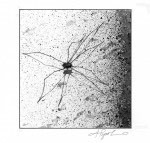
Waiting for a friend in town, I stood near a broad stone wall of rough-faced blocks of Vermont granite. The hot sun beat down uncomfortably from the south, so I decided to walk around to the other side of the wall, seeking whatever shade it provided.
As I leaned against the cool, northern face of the wall, I began looking closely at the granular texture, forgetting why I was there. Here was a new habitat to explore: an isolated stone surface erected upon an open, grassy setting where no natural rocky outcrops were present.
I took mental inventory of clumps of thick moss glistening with unevaporated moisture, and a healthy variety of lichens, both erect fruticose ones and scaly foliose types. Damp stains of green algae spotted the granite, and a few brave, leafy sprouts with no possible future grew tentatively from narrow cracks between fitted blocks.
A thread-legged harvestman stepped delicately across the rough surface, waving its sensory second pair of legs. At wide intervals, a few large, black ants followed a predecessor’s scent trail, and a dun-colored moth huddled motionless on a mortar-filled crack. An iridescent beetle waved clubbed antennae as it explored the rocky expanse before disappearing into a cluster of moss.
The closer I inspected the shaded granite wall and its craggy topography, the more animal life I saw. Tiny mites at the limit of vision scurried over the rough terrain. Wherever there was a sheltering concavity, bits of webbing spun by minute, waiting spiders stretched across the openings. When I probed one moss colony, a small millipede left its shelter and crawled onto the open rock, legs rippling smoothly.
Curious to learn more, I left the shady north wall and returned to the opposite, sunny side of the wall. This orientation, with its southern exposure, received more light and heat, the surface was hot to the touch and thus sported micro-flora typical of a xerophytic habitat. Here, lichens were flat, dried-looking, crustose forms that hugged the rocky surface. Mosses were scarce and desiccated; one that seemed at home in the heat and dryness, Grimmia, is a member of a familiar genus I’d formerly seen on hot, exposed volcanic slopes.
Long, tightly chained columns of very small ants, stimulated by the heated surface, streamed busily along invisible scent trails laid down by their scouts. A dragonfly flew clattering to perch on the granite, abdomen swelling and deflating as it pumped in air and exhaled. A large greenhead horsefly alighted and walked on elevated legs across the hot surface, but it took off when a hirsute robberfly - insulated against the heat - cruised by searching for a victim. It was an entirely different world from the darker, cooler one a dozen feet away on the other side of the wall.
These contrasting environmental conditions within what at first looked like a single habitat showed that subdivisions are identifiable as microhabitats simply by conditions of light and dark, moisture and aridity, movement of air and water, and degree of shelter.
We’ve all noticed such phenomena and sometimes relied upon them. Early hunter-gatherers used nature’s directional indicators. Moss, for example, reliably grows most abundantly on the north side of a tree, a fact noted tens of thousands of years before the Chinese invented north-pointing compasses.
One maple towering above our rock garden is close enough to allow scrutiny with binoculars from an upstairs window. I inspect plant and animal populations profiled on both the sunny and the shaded sides of the trunk. Mosses, liverworts, lichens, fungi, and slime molds are predictably zoned according to light and moisture. It’s possible to identify a variety of insects coursing up and down one side or the other, each kind seeming to prefer warm light or cool shadow, ample or lessened moisture.
Wind is an added challenge. Different sides of a boulder sticking out from a wind-swept mountain ledge support populations of small plants and animals zoned according to their tolerance of this occasionally powerful force. Even if air movement is slight, it may encourage more evaporation on one side of a three-dimensional object than another, so plant and animal zonation can be determined by a few degrees of humidity, rather than visible surface moisture.
After my experience with the urban granite wall, I’ve begun to look at different sides of features I come across. On a recent trip to New York City, I wondered about skyscrapers and their exposure to sun and shade, rain, wind, and shelter. What small creatures live up there by preference, and on which sides? What tiny plants take hold hundreds of feet above the busy streets? There is a story to be told, but zoned life on tall buildings isn’t for me. It’s a subject for Spiderman.

